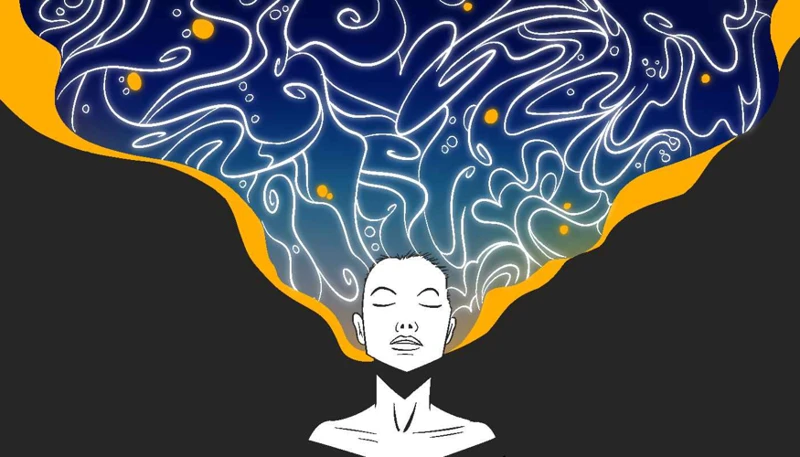Welcome to the mysterious realm of dreams, where our subconscious minds weave intricate tales that unravel the depths of our emotions and fears. Each night, as we surrender ourselves to slumber, we are transported to a realm beyond logic and reason. In this article, we embark on a journey to decode the emotions behind fear in dreams and unravel the enigmatic aspects of our nightmares. Delve into the psychology of fear, explore the symbolism that lies beneath the surface, and uncover the hidden messages that our dreams hold. Join us as we navigate the labyrinth of our subconscious and unravel the mystery that lies within. Let’s dive deep into the intriguing world of dreams and unlock the secrets that lie within our mind’s nocturnal theater.
The Intriguing World of Dreams

As we venture into the intriguing world of dreams, we are transported to an ethereal realm where the boundaries of reality and imagination blur. Dreams, with their enigmatic symbolism and purpose, have puzzled and fascinated humanity for centuries. What Are Dreams? They are a state of consciousness that occurs during sleep, where our minds conjure vivid images, emotions, and narratives. Often elusive and fleeting, dreams serve as a gateway to our deepest desires, fears, and unresolved emotions. Within this realm, fear takes center stage, with its mysterious and haunting presence. The Nature of Fear in Dreams can range from subtle unease to terror, leaving us breathless and disoriented upon waking. To better understand this enigma, it is crucial to explore the psychology of fear and its impact on our dreamscape.
1.1 What Are Dreams?
- What Are Dreams?
Dreams are intricate and complex experiences that unfold during our sleep. They are a manifestation of our subconscious mind, creating a rich tapestry of images, emotions, and narratives. Dreams can range from fleeting fragments to elaborate storylines that engage our senses and emotions. When we close our eyes and drift off into slumber, our brain enters various stages of sleep, including REM (Rapid Eye Movement) sleep. It is during REM sleep that dreams occur most frequently. In this state, our brains are highly active, resembling wakefulness. However, our muscles are relaxed, preventing us from acting out our dreams physically.
Dreams serve as a means of processing and integrating our daily experiences, thoughts, and emotions. They provide a platform for our minds to explore uncharted territories and delve into the depths of our unconscious. Dreams can be influenced by external factors such as events of the day, conversations, and even the media we consume. They can also be influenced by internal factors, including our emotional state, memories, and personal beliefs.
Exploring the realm of dreams can be a fascinating and enlightening endeavor. By analyzing the symbolism and patterns within our dreams, we can gain insights into our subconscious desires, fears, and unresolved conflicts. Dream interpretation has been a subject of interest for psychologists, philosophers, and spiritualists alike, giving rise to various theories and interpretations.
To unlock the meaning behind our dreams, we can delve into the vast and intriguing world of dream symbolism, where each image, object, or scenario holds a deeper significance. By unraveling the hidden messages that dreams convey, we can uncover surprising revelations about ourselves and our innermost desires and fears. So, let us embark on this journey of self-discovery, where we embrace the enigmatic realm of dreams and uncover their profound secrets.
1.2 The Nature of Fear in Dreams
The Nature of Fear in Dreams
Fear, a primal emotion deeply rooted in our psyche, manifests itself uniquely in the realm of dreams. In the mysterious landscape of our dreamscape, fear takes on various forms and intensities, often leaving us bewildered and shaken upon waking. While the origins of fear in dreams can stem from a multitude of factors such as personal experiences, anxieties, and unresolved traumas, it is crucial to recognize that fear in dreams serves a purpose beyond mere entertainment or torment. It acts as a conduit for our subconscious mind to communicate and process underlying emotions and concerns. Dream fear can manifest as phobias, nightmares, or unsettling scenarios that tap into our deepest insecurities and vulnerabilities. These fearful encounters can range from being chased by an unknown entity, falling from great heights, or even facing supernatural beings. Each fear holds a profound significance, providing us with valuable insights into our own psyche. Unraveling the symbolism behind these fearful dream encounters can shed light on the underlying emotions and unresolved issues we may be grappling with in our waking lives. By delving into the nature of fear in dreams, we embark on a journey to unravel the depths of our subconscious mind and decipher the messages it seeks to convey.
The Psychology of Fear

In the intricate realm of psychology, fear emerges as a primal and innate human response. Understanding Fear and Its Origins allows us to delve into the depths of our subconscious and unravel the complexities that fuel our dreams. Fear is not merely a negative emotion but serves as a vital survival mechanism, rooted in our evolutionary history. It triggers a series of physiological and psychological responses, preparing us for fight, flight, or freeze. Within the context of dreams, fear manifests in various forms, symbolizing our deepest anxieties, unresolved traumas, or even hidden desires. By delving into the psychology of fear, we gain valuable insights into the intricate web of our dreams and decipher the hidden meanings they hold. As we explore the symbolism of surprise and shock in dream symbolism, we uncover the layers of interpretation and personal significance that fear carries within our nocturnal escapades.
2.1 Understanding Fear and Its Origins
Understanding fear and its origins is key to unraveling the complex dynamics of our dreams. Fear, a powerful and primal emotion, has been deeply ingrained in our evolutionary history as a survival mechanism. It is an intense emotional response triggered by a perceived threat or danger, activating our fight-or-flight response. In the context of dreams, fear can manifest in various ways, often linked to our subconscious anxieties and unresolved traumas. But where does fear come from? The origins of fear can be traced back to a combination of innate factors and learned experiences. From an evolutionary perspective, fear protects us from potential harm and ensures our survival. It is an instinctual response, deeply rooted in our brains to help us navigate and respond to dangerous situations. Our past experiences, traumas, and conditioning shape our perception of fear. These personal experiences can create emotional triggers that are later incorporated into our dreams, amplifying our fears and anxieties. By examining the origins of fear in our waking lives, we can begin to decipher the underlying meanings and representations it takes on in our dreams. This understanding provides a gateway to unlocking the hidden messages and symbols within our nocturnal adventures. To delve deeper into the world of dreams and their symbolic representations, you can explore the symbolism of love and romance in dreams. This adds another layer to our understanding of fear, as it intertwines with other emotions and themes in the realm of dreams.
2.2 Fear as a Survival Mechanism
Fear, as a primal emotion, serves as a vital survival mechanism wired deep within our human psyche. When we encounter threats or potential dangers in our waking lives, fear activates our fight or flight response, preparing us for self-preservation. In dreams, fear manifests as a symbolic representation of our instinctual drive for survival. Our nightmares often tap into this primal fear, simulating threatening situations that trigger our natural instinct to protect ourselves.
One reason fear in dreams serves as a survival mechanism is that it can act as a rehearsal for real-life threatening situations. During dreams, our minds simulate scenarios that tap into our fears, allowing us to mentally and emotionally prepare for potentially dangerous situations. This rehearsal process enables us to develop strategies, anticipate outcomes, and enhance our survival instincts in waking life.
Fear in dreams can also act as a warning system, alerting us to potential threats or highlighting unresolved fears and anxieties. Our subconscious mind may use fear as a mechanism to bring our attention to buried traumas, deep-seated anxieties, or unresolved issues. By confronting these fears in the safe environment of dreams, we have the opportunity to process and heal from them in a controlled setting.
It is important to note that dreams allow us to experience fear without the physical consequences present in reality. This provides a unique opportunity for us to explore and confront our fears in a safe and controlled manner, ultimately empowering us to overcome them.
Fear in dreams serves as a survival mechanism by allowing us to mentally rehearse and prepare for potential threats in our waking lives. It acts as a warning system to address unresolved fears and anxieties, providing an avenue for healing and growth. Through the mechanisms of fear in our dreams, we are able to enhance our survival instincts, develop coping strategies, and ultimately embrace a sense of empowerment.
Exploring the Symbolism of Fear in Dreams

In the realm of dreams, fear manifests itself in various symbolic forms, offering us a gateway to explore the depths of our subconscious. Common Dream Fear Themes often include being chased, falling, or confronting supernatural entities. These themes may represent feelings of vulnerability, powerlessness, or unresolved conflicts in our waking lives. Additionally, Personalized Fear Symbols uniquely tailored to each individual might appear in dreams. These symbols could range from animals, objects, or even specific people, all of which hold personal significance and carry hidden messages. By delving deeper into the symbolism of fear in dreams, we can unravel the intricate tapestry of our subconscious minds and gain valuable insights into our fears, anxieties, and unresolved emotions.
3.1 Common Dream Fear Themes
When it comes to dreams, fear manifests itself in various themes that are commonly experienced by individuals. These fear themes often reflect our deepest anxieties and concerns, and they can range from the mundane to the extraordinary. One common fear theme revolves around falling, where individuals dream of plummeting from great heights, leading to a sense of helplessness and vulnerability. Another prevalent fear theme is being chased or pursued, with sinister figures or unknown entities relentlessly on our heels. This dream evokes a primal instinct to flee or escape, bringing forth intense feelings of fear and panic.
Nightmares about being trapped or imprisoned are also common fear themes. In these dreams, individuals may find themselves confined in small spaces or unable to escape from a dangerous situation, leading to feelings of claustrophobia and confinement. Another fear theme involves the loss or harm of loved ones, where individuals experience dreams that depict the death or injury of family members or friends. These dreams tap into our deep-rooted fears of abandonment and loss.
Additionally, fear themes related to natural disasters, such as earthquakes, tsunamis, or tornadoes, are frequently encountered in dreams. These dreams often signify a sense of instability and chaos in one’s life, where individuals may feel overwhelmed and powerless in the face of uncontrollable forces.
It is important to note that while these fear themes may be common, their meanings and interpretations can vary greatly from person to person. The context and personal experiences of the dreamer play a significant role in deciphering the underlying emotions and messages within these dreams. By examining these common fear themes and exploring their personal significance, individuals can gain valuable insights into their subconscious fears and anxieties.
3.2 Analyzing Personalized Fear Symbols
In the intricate tapestry of dreams, personalized fear symbols play a pivotal role in unraveling the depths of our subconscious mind. Each individual possesses a unique set of experiences, memories, and emotions, which shape the symbolism that appears in their dreams. Analyzing these personalized fear symbols can provide invaluable insights into our deepest fears, anxieties, and unresolved issues. When it comes to decoding these symbols, it is essential to approach them with an open mind and a willingness to explore their possible meanings. Rather than relying on universal interpretations, it is crucial to delve into the personal associations and emotional significance these symbols hold for the dreamer. By examining the context, emotions, and personal history associated with the symbol, we can begin to unravel its hidden messages and unlock a deeper understanding of our subconscious fears. It is important to note that these symbols may not always be easily recognizable or straightforward. They may manifest as metaphors, abstract representations, or even seemingly unrelated objects or scenarios. The key is to trust your intuition and the feelings evoked by these symbols, as they hold the key to their hidden meanings. Engaging in self-reflection, keeping a dream journal, and seeking the guidance of a professional dream analyst can greatly assist in analyzing and deciphering these personalized fear symbols. Through this process, we can gain profound insights into our innermost fears, enabling us to confront and heal from them in our waking lives.
Unraveling the Emotional Significance of Fear in Dreams

Delving deeper into the realm of dreams, we begin to unravel the emotional significance of fear that resides within our subconscious minds. Within the fabric of our dreamscape, fear serves as a powerful indicator of unresolved traumas and deep-set anxieties. Unresolved Traumas and Deep-set Anxieties often find expression in our dreams, manifesting as fear-inducing scenarios and symbols. Our dreams become a conduit for the processing and exploration of these lingering emotional wounds, offering us a unique opportunity for healing and growth. Furthermore, The Role of Fear in Dream Processing is vital, as it acts as a catalyst for examining our fears, confronting them, and ultimately integrating them into our waking lives. By courageously exploring the emotions behind our fears in dreams, we embark on a profound journey of self-discovery and emotional transformation.
4.1 Unresolved Traumas and Deep-set Anxieties
Unresolved traumas and deep-set anxieties can manifest in our dreams as fear-inducing scenarios and unsettling imagery. Our subconscious mind has a powerful way of processing and reliving past experiences, especially those that have left a profound emotional impact on us. When traumas, whether big or small, remain unresolved, they can become stored deep within our psyche, influencing our thoughts, behaviors, and dreams. In the realm of dreams, unresolved traumas may resurface, often in symbolic form, as our minds attempt to cope with and make sense of these deeply ingrained experiences. These dreams might manifest as recurring nightmares or disturbing scenarios related to the traumatic events or the associated emotions. Similarly, deep-set anxieties, such as fear of failure, abandonment, or rejection, can find their way into our dream narratives, amplifying our subconscious worries and triggering fear responses during sleep. By paying attention to the content and emotions within these dreams, we can gain insight into the unresolved traumas and anxieties that still hold power over us. This awareness opens the door to healing and addressing these underlying issues, ultimately allowing us to find greater peace and freedom both in our dreams and waking lives.
4.2 The Role of Fear in Dream Processing
Fear plays a significant role in the intricate process of dream processing, influencing the themes, intensity, and emotional impact of our dreams. The Role of Fear in Dream Processing can be seen as a protective mechanism that allows our subconscious mind to confront and address unresolved fears and anxieties. Dreams serve as a psychological playground where we can explore and process these emotions in a safe and controlled environment. Fear in dreams serves as a signal for potential dangers or areas of our lives that require attention or healing. It acts as a catalyst, pushing us to confront our deepest fears, break free from limitations, and seek resolution. Whether it’s the fear of failure, abandonment, or loss, our dreams can amplify these emotions to bring them to our conscious awareness. By confronting and processing these fears within the dream state, we can gain valuable insights and emotional healing. It is through facing our fears in the realm of dreams that we can unlock personal growth, resilience, and transformation in our waking lives. Despite the unsettling nature of fear in dreams, it serves as a powerful tool for self-discovery and emotional integration.
Methods to Decode Fearful Dreams

When it comes to decoding the perplexing world of fearful dreams, there are several effective methods that can help shed light on their hidden meanings. Dream Journaling and Reflection serves as a powerful tool in understanding the patterns, symbols, and emotions that surface during our dream experiences. By recording our dreams immediately upon waking and analyzing them with a fresh mind, we can uncover recurring themes and gain insight into our subconscious fears. Another valuable approach is Seeking Professional Help. Consulting with a therapist or dream analyst can provide a deeper understanding of the underlying emotions and psychological significance behind our fearful dreams. Their expertise can offer guidance and support as we navigate the intricate landscapes of our unconscious mind. By combining these methods, we embark on a journey of self-discovery, gradually unravelling the complexities and unraveling the mystery of fear in our dreams.
5.1 Dream Journaling and Reflection
Dream journaling and reflection is a powerful technique for decoding and understanding the emotions behind fear in dreams. By keeping a dream journal, you create a sacred space to record your dreams upon waking. The act of writing allows you to capture details, emotions, and symbols that may fade from memory as the day progresses. It is essential to be consistent and diligent with your journaling practice, as patterns and recurring themes may emerge over time. Reflecting upon your dreams can provide valuable insights into the underlying emotions and fears that manifest. Sit down with your dream journal and read through your entries. Look for common symbols, themes, and emotions that recur across different dreams. Pay attention to the circumstances or situations that trigger fear in your dreamscape. Are there any underlying anxieties or unresolved traumas that surface in your dreams? Use the power of reflection to delve deeper into the meaning behind your dreams. As you analyze and interpret your dream entries, try to connect the emotions and symbols to events or experiences in your waking life. This introspective process allows you to gain a deeper understanding of your fears and anxieties, empowering you to confront and address them in a conscious and meaningful way. Remember, the dream journal is a personal tool for self-discovery and growth, so be open to your own interpretations and insights.
5.2 Seeking Professional Help
Seeking professional help can be a valuable step in decoding the emotions behind fear in dreams. Sometimes, the complexities and intensity of our dreams may require the guidance of a trained therapist or dream analyst. These professionals possess the expertise and knowledge to delve into the intricacies of dream symbolism and help unravel the underlying messages. By engaging in therapy or dream analysis, individuals can gain a deeper understanding of their fears, anxieties, and unresolved traumas that manifest in their dreams. Therapists can provide a safe and supportive environment for individuals to explore their dreams, allowing for introspection and emotional release. Through various therapeutic techniques such as talk therapy, cognitive-behavioral therapy, or even techniques specific to dream work, individuals can find solace and insight into the fears and emotions embedded in their dreams. A professional perspective can offer an objective interpretation of dream symbolism, allowing individuals to gain clarity and self-awareness. If your dreams continue to evoke distress or hinder your well-being, seeking professional help can be an empowering step towards unraveling the mysteries of your dreams and finding peace within your subconscious mind. Remember, there is no shame in seeking assistance; it is a brave act towards self-discovery and healing.
Embracing and Overcoming Fear in Your Dreams
In the realm of dreams, fear can be both a source of distress and an opportunity for growth. By embracing and overcoming fear in our dreams, we can harness their transformative power and gain a deeper understanding of ourselves. Transformation and Empowerment lie within our grasp as we navigate the scary landscapes of our nightmares, for it is through facing our fears that we can conquer them. Dreams provide a safe space to confront our deepest anxieties, and by confronting them head-on, we can cultivate resilience and strength in our waking lives. Additionally, Techniques for Lucid Dreaming can empower us to take control of our dreams, giving us the ability to change the narrative and conquer our fears within the dream world itself. Embracing and overcoming fear in our dreams is a courageous act that paves the way for personal growth, self-discovery, and a newfound sense of empowerment in our waking lives.
6.1 Transformation and Empowerment
One of the most intriguing aspects of fear in dreams is its potential for transformation and empowerment. While nightmares can be unsettling, they also present an opportunity for personal growth and self-discovery. Transformation occurs when we confront and overcome our fears within the dream realm, allowing us to carry that newfound strength and resilience into our waking lives.
In the realm of dreams, empowerment is achieved by understanding and harnessing the power of our fear. By acknowledging our fears and facing them head-on, we gain a sense of control and mastery over the challenges that arise. This can have a ripple effect in our everyday lives, boosting our confidence and empowering us to tackle obstacles with renewed determination and courage.
There are several techniques that can facilitate transformation and empowerment in dreams. Practicing lucid dreaming allows individuals to become aware that they are dreaming and take an active role in shaping the dream narrative. This awareness provides an opportunity to confront and conquer fears, transforming the dream into a positive and empowering experience.
Additionally, embracing a mindset of curiosity and exploration within dreams can lead to transformative experiences. By reframing fear as an opportunity for growth, individuals can approach their nightmares with a proactive and empowering mindset, seeking to understand the messages and lessons hidden within.
6.2 Techniques for Lucid Dreaming
Lucid dreaming is a fascinating phenomenon where the dreamer becomes aware that they are dreaming and gains control over the dream’s narrative. It opens up a realm of possibilities, allowing individuals to actively participate in their dreams and shape their experiences. While achieving lucidity in dreams can be challenging, various techniques can increase the likelihood of having lucid dreams.
Reality Testing: Incorporating reality testing into your daily routine can help train your mind to question the nature of reality. This involves regularly checking your surroundings, asking yourself if you are dreaming, and performing simple tests, such as trying to push your finger through a solid object. By making this a habit, you increase the chances of performing the same test within a dream and realizing that you are in a dream state.
Mnemonic Induction of Lucid Dreams (MILD): MILD is a technique developed by Dr. Stephen LaBerge, a renowned expert in the field of lucid dreaming. It involves waking up after 4-6 hours of sleep, staying awake for a short period of time while focusing on the idea of having a lucid dream, and then going back to sleep with the intention of becoming lucid. This technique capitalizes on the brain’s heightened suggestibility during the transition between sleep cycles.
Wake-Induced Lucid Dreams (WILD): This technique involves maintaining a state of consciousness while transitioning from wakefulness to the dream state. It requires entering a state of deep relaxation while remaining mentally awake. As your body falls asleep, you maintain awareness, ultimately allowing yourself to enter the dream world with full lucidity.
Keeping a Dream Journal: A dream journal is an invaluable tool for lucid dreaming. Keep a notebook and pen by your bed to record your dreams as soon as you wake up. By consistently recording your dreams, you become more attuned to their patterns, symbols, and themes. This heightened self-awareness can help trigger lucidity within future dreams.
Visualization and Affirmations: Before sleep, visualize yourself becoming aware and in control within your dream. Repeat affirmations such as “I will have a lucid dream tonight” or “I am aware within my dreams” to reinforce your intentions. This practice helps focus your mind and positively influences the content of your dreams.
Remember, achieving lucid dreams may require patience and practice. It is essential to maintain a regular sleep schedule, prioritize relaxation, and cultivate a mindset of curiosity and openness. With dedication and these techniques, you can embark on extraordinary adventures within the realm of lucid dreaming.
Conclusion
In , decoding the emotions behind fear in dreams and unraveling the mystery of our nightmares is a fascinating and introspective journey. By exploring the nature of dreams, the psychology of fear, and the symbolism within our dreamscape, we gain valuable insights into our subconscious mind and emotional landscape.
Dreams provide a unique opportunity for self-reflection, enabling us to analyze and confront our fears, anxieties, and unresolved traumas. By keeping a dream journal and reflecting on the themes and symbols that recur in our dreams, we can begin to uncover the hidden messages that our subconscious is trying to convey.
However, it is worth noting that dream interpretation is subjective, and what holds true for one individual may differ for another. Seeking the guidance of a professional, such as a therapist or dream analyst, can provide further clarity and understanding.
Ultimately, embracing and overcoming fear within our dreams can lead to personal growth and transformation. Techniques for lucid dreaming, where we become aware and in control of our dreams, can empower us to face our fears head-on and rewrite the narrative.
With curiosity and an open mind, we can continue to explore the depths of our dream world, knowing that they hold a wealth of knowledge and insights waiting to be uncovered. So, next time you find yourself in the realm of dreams, remember to dive deep, confront your fears, and embrace the transformative power of your nocturnal adventures.
Frequently Asked Questions
1. What causes us to experience fear in dreams?
Fear in dreams can be triggered by a variety of factors, including unresolved traumas, anxieties, and subconscious fears. It can also be influenced by external stimuli, such as watching a scary movie before bed or being in a stressful situation.
2. Are all dreams infused with fear?
No, not all dreams are infused with fear. Dreams can encompass a wide range of emotions and themes, including happiness, love, excitement, and even mundane activities. Fear in dreams tends to be more prominent when we are dealing with unresolved emotions or deep-seated anxieties.
3. Why do recurring nightmares happen?
Recurring nightmares can occur when our subconscious is attempting to bring unresolved issues to the surface. They often serve as a way for our minds to process and deal with unresolved traumas, fears, or anxieties. Exploring the underlying themes and emotions in these nightmares can help us address and overcome these issues.
4. Can interpreting dream symbols help understand fear in dreams?
Absolutely! Dream symbols can provide valuable insights into the underlying emotions and fears in our dreams. By analyzing and interpreting these symbols, we can gain a deeper understanding of our subconscious mind and the messages it is trying to communicate to us.
5. How can fear in dreams be beneficial?
Fear in dreams can be beneficial as it acts as a form of emotional release and catharsis. It allows us to confront and process our deepest fears and anxieties in a safe environment. By facing our fears in dreams, we can gain a sense of empowerment and develop coping mechanisms to deal with them in waking life.
6. Can dreams provide insights into our waking life fears?
Yes, dreams can provide valuable insights into our waking life fears. They often reflect our subconscious thoughts and emotions, offering a window into our deepest fears and anxieties. By paying attention to the symbolism and emotions in our dreams, we can gain a better understanding of the fears that may be influencing our daily lives.
7. Is it possible to control the fear in our dreams?
Yes, it is possible to control the fear in our dreams through lucid dreaming. Lucid dreaming is the practice of becoming aware that you are dreaming while still in the dream state. With practice and techniques, you can learn to confront and transform your fears, turning them into opportunities for growth and self-empowerment.
8. Can seeking professional help be beneficial for recurring nightmares?
Absolutely. If recurring nightmares are causing significant distress or interfering with daily life, seeking professional help from a therapist or dream specialist can be beneficial. They can provide guidance and techniques to address the underlying issues and help you find relief from the distressing nightmares.
9. Can journaling our dreams help unlock the meaning behind fear?
Yes, journaling our dreams can be a powerful tool in unlocking the meaning behind fear. By consistently recording the details of our dreams, we can identify patterns, themes, and recurring symbols. This record can serve as a valuable resource for analysis and uncovering the deeper emotional significance of our fears in dreams.
10. Are nightmares a sign of mental health issues?
Not necessarily. Nightmares can be a normal part of the dream cycle and are often a reflection of the subconscious mind processing emotions and experiences. However, if nightmares are frequent, distressing, or accompanied by other symptoms of mental health issues, it may be beneficial to seek professional evaluation and guidance.








